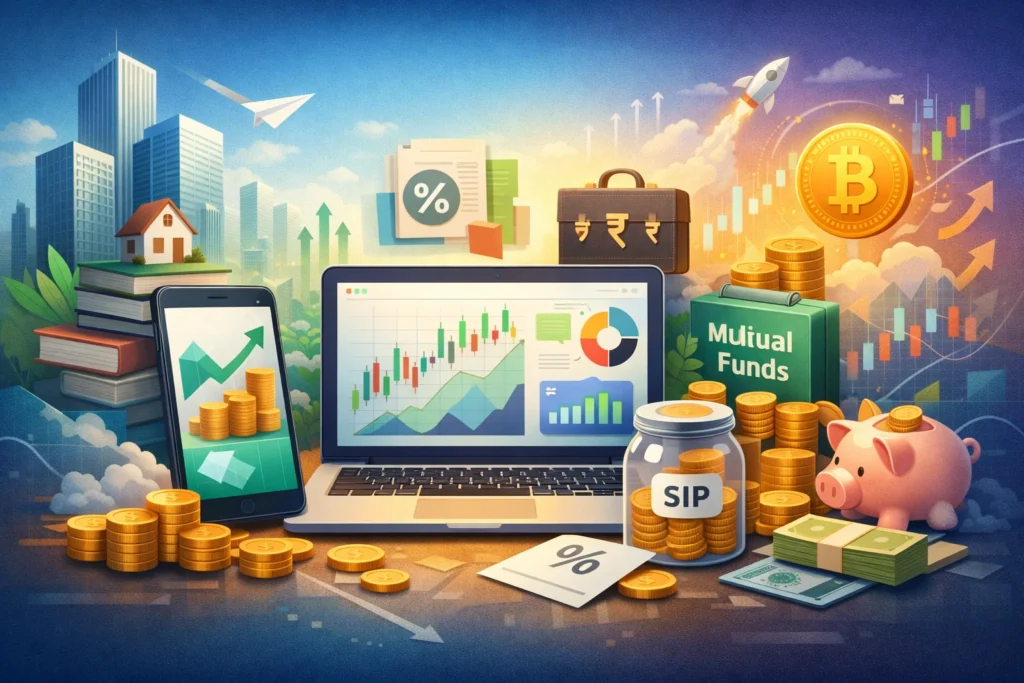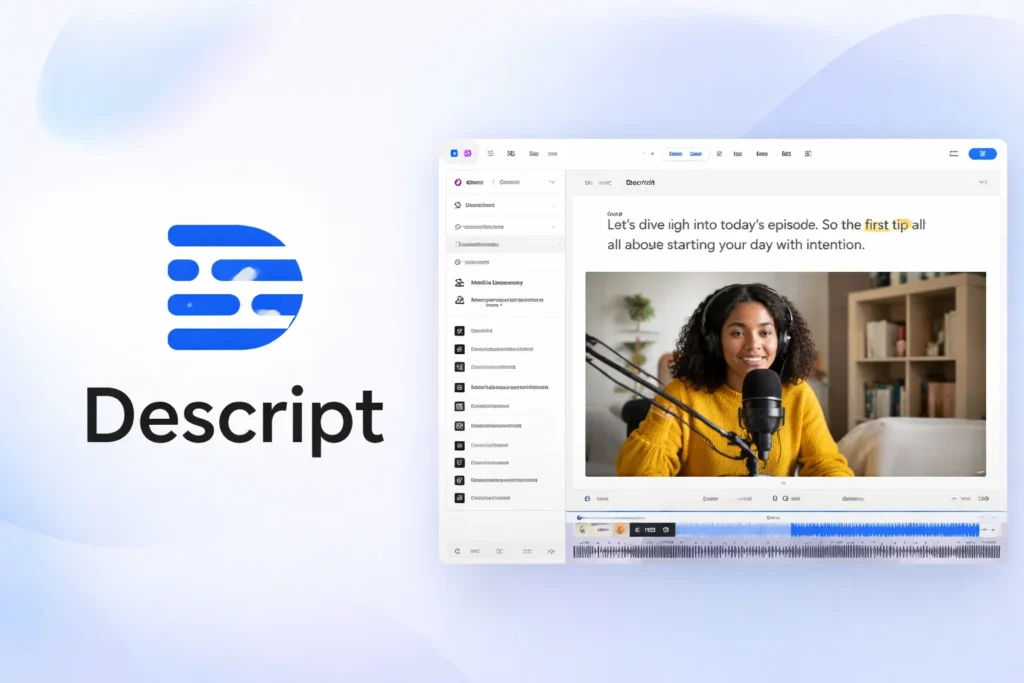In today’s fast-paced world, food delivery apps have revolutionized the way we dine. Whether it’s a quick meal at work or a family dinner at home, platforms like Foodpanda have made it incredibly convenient to order food from favorite restaurants with just a few taps. Building a Foodpanda clone offers a huge business opportunity, especially with the continuous rise of the online food delivery market, which is expected to grow exponentially in the coming years.
Creating an app similar to Foodpanda isn’t just about copying features; it’s about understanding the technology, the user experience, and the industry trends to develop a platform that meets modern customer demands. This guide will take you through the features, costs, and development process of building your own Foodpanda-style app, ensuring your product is both competitive and scalable in today’s market.
For companies like Miracuves Solutions, bringing such an idea to life is more than possible. They specialize in creating robust, user-friendly apps tailored to the specific needs of businesses like yours, offering the expertise needed to build and launch a food delivery app that stands out.
What is Foodpanda and What Does It Do?
Foodpanda is a globally recognized food delivery platform that connects customers with restaurants and food vendors in their area. Launched with the aim of simplifying the process of ordering food, Foodpanda has grown into a robust platform offering an easy, intuitive user experience for ordering meals from a wide range of cuisines.
The app functions as a bridge between customers and restaurants, offering features such as real-time order tracking, seamless payment options, and personalized restaurant recommendations. Whether a user is craving a local dish or fast food from an international chain, Foodpanda ensures the food arrives quickly, making it a go-to choice for millions worldwide.
How Foodpanda Works:
- User App: Customers can browse restaurants, view menus, place orders, and track deliveries in real-time.
- Restaurant App: Restaurants receive and manage orders, update menus, and track sales.
- Delivery Partner App: Couriers accept orders, use GPS navigation for deliveries, and complete the delivery cycle.
- Admin Panel: The backbone of the operation, managing the ecosystem, user data, and logistics.
Foodpanda’s success lies in its ability to seamlessly integrate these different user groups while offering a flawless experience for both customers and service providers.
Why Build an App Like Foodpanda?
The rise of food delivery apps has transformed the food service industry, and developing a Foodpanda clone presents a huge business opportunity. With the convenience of ordering food from a variety of restaurants through an app, the demand for such platforms has soared. People want food fast, and they want choices—all at their fingertips.
The online food delivery industry is booming, with projections indicating it will surpass $200 billion in global revenue by 2025. This growth is fueled by an increase in smartphone usage, changing lifestyles, and the need for contactless delivery options. For entrepreneurs and businesses, creating an app like Foodpanda allows them to tap into this growing market while offering users a modern, convenient way to enjoy their meals.
Business Opportunities:
- High Demand: As people continue to embrace convenience, food delivery apps are becoming a necessity rather than a luxury.
- Recurring Revenue Streams: Whether through delivery fees, restaurant commissions, or premium subscriptions, a Foodpanda-like app can generate steady income.
- Expanding Beyond Food: With an established delivery platform, you can easily branch out into other services like grocery delivery or meal kits.
By developing an app like Foodpanda, you not only cater to today’s consumer demands but also open up avenues for scaling your business into new markets and services.
How to Differentiate Your App from Competitors
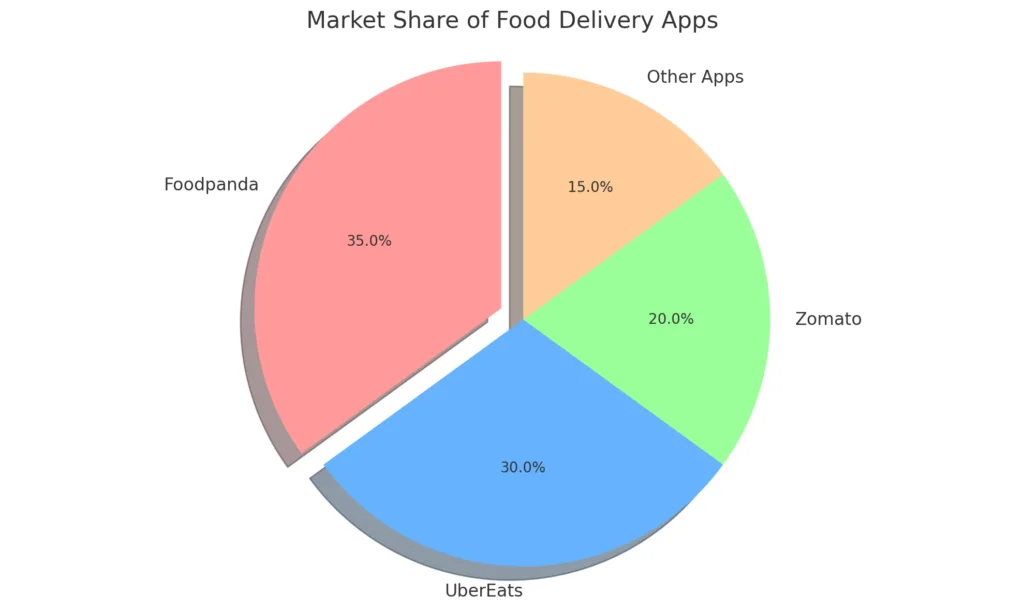
In a crowded market like food delivery, it’s crucial to make your Foodpanda clone stand out. Simply copying existing apps won’t guarantee success. Instead, focus on creating a unique value proposition that sets your app apart from the competition. This can be achieved by offering innovative features, targeting underserved markets, or enhancing the user experience in meaningful ways.
Unique Features to Stand Out:
- Customizable Meal Plans: Allow users to build meal plans based on dietary preferences or restrictions, such as vegan or keto diets.
- Subscription-Based Delivery: Offer users the ability to subscribe for unlimited deliveries at a flat monthly fee, providing more value and increasing loyalty.
- Sustainability Options: Include eco-friendly delivery methods or options for zero-plastic packaging to attract environmentally conscious consumers.
Niche Targeting:
Identifying and serving a niche audience can also help differentiate your app. For example, focus on delivering gourmet food, late-night meals, or even home-cooked dishes. You could also prioritize specific geographic regions where large competitors haven’t fully penetrated.
By identifying market gaps and implementing these strategies, you can create a food delivery app that doesn’t just compete with giants like Foodpanda, but carves out its own loyal user base.
Read More “Types of Food Delivery App and the Secret to Their Success“
Market Size, Growth, and Business Model
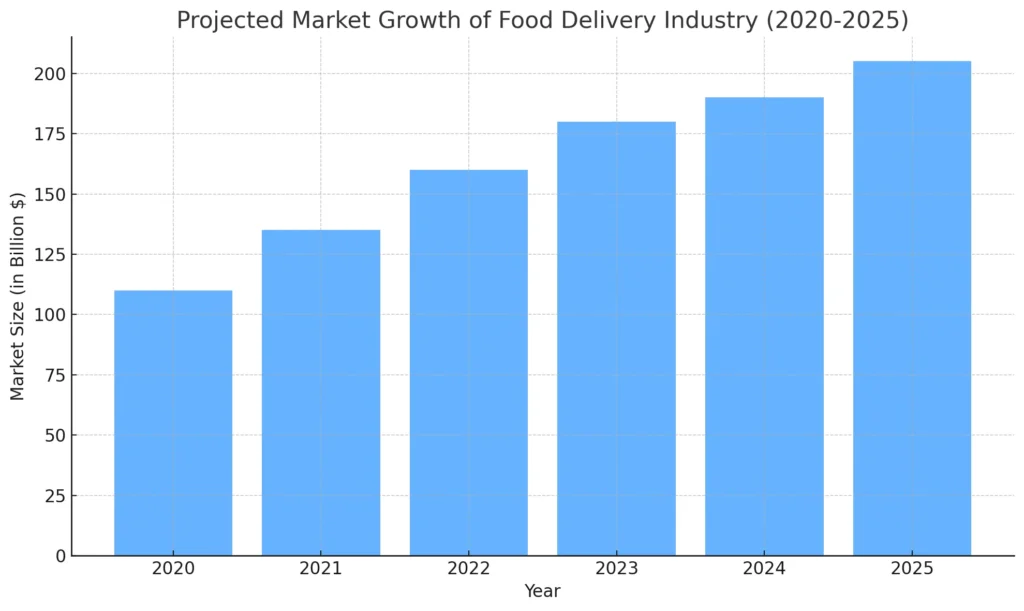
The food delivery industry has seen tremendous growth over the past few years, driven by a shift in consumer behavior, increased smartphone penetration, and the demand for convenience. According to industry reports, the global food delivery market is expected to reach over $200 billion by 2025, showing no signs of slowing down. This growth is not just limited to developed nations but is spreading across emerging markets, where food delivery services are becoming increasingly popular.
Market Growth Potential:
- Rising Demand for Convenience: More consumers are opting for home delivery instead of dining out, especially post-pandemic, which has significantly increased the demand for food delivery apps.
- Expansion into New Segments: Beyond traditional restaurant food, there’s potential to expand into grocery delivery, meal kits, and even fresh produce, further driving market growth.
- Tech-Driven Innovation: With the integration of AI, real-time tracking, and personalized recommendations, food delivery apps are constantly evolving, creating new opportunities for developers.
Business Model for a Foodpanda Clone:
A Foodpanda clone can adopt multiple business models to generate revenue:
- Commission-Based: Charge a percentage fee from partner restaurants on every order placed through the app.
- Delivery Fees: Customers can be charged a delivery fee, especially for long-distance deliveries or during peak hours.
- Subscription Model: Offer users a premium subscription for benefits like free delivery, exclusive discounts, and priority service.
- In-App Advertising: Allow restaurants to advertise within the app for higher visibility.
Key Features of a Foodpanda Clone
| Feature | User | Restaurant | Admin |
|---|---|---|---|
| Registration & Profiles | Create and manage user profiles | Restaurant registration and profiles | Admin can manage user and restaurant profiles |
| Browse & Search | Search restaurants and filter options | View user preferences and order history | Monitor search trends and popular restaurants |
| Order Placement | Place, customize, and track orders | Receive and manage incoming orders | View all orders and update statuses |
| Real-Time Tracking | Track orders via GPS | Update order status in real-time | Monitor order status and delivery fleet |
| Payments | Multiple payment methods | Track payment status | Manage payment gateways and transaction reports |
| Menu Management | View menus with detailed customization | Update menus, pricing, and availability | Manage restaurant menus and resolve discrepancies |
| Analytics & Reports | Order history and recommendations | View sales reports and performance | Generate reports for overall app performance |
To create a successful Foodpanda clone, your app needs to offer a robust set of features that cater to users, restaurants, and delivery partners. These features will not only define the user experience but also set the foundation for efficient operations and long-term growth.
Essential User Features:
- User Registration and Profile Management: Allow users to sign up via email, social media, or phone numbers. Profile management lets them save delivery addresses, payment methods, and order history.
- Restaurant Listings and Search: Users should easily browse through restaurants based on their location, cuisine, or even dietary preferences. Integrating filters and search options enhances user convenience.
- Order Placement and Customization: Make it easy for users to place orders, customize their meals, and add special instructions for the restaurant or delivery person.
- Real-Time Order Tracking: Real-time GPS tracking keeps users informed of their delivery status, providing updates from order confirmation to delivery.
- Multiple Payment Options: Support a wide range of payment methods, including credit cards, digital wallets, and cash on delivery, ensuring a smooth checkout process.
Essential Admin Features:
- Restaurant Management Dashboard: Allows restaurant owners to update menus, manage orders, track deliveries, and view performance analytics.
- Order Management System: Real-time order management that helps monitor incoming orders, prepare them efficiently, and assign delivery partners.
- Analytics and Reporting: Provide detailed reports on orders, revenue, user engagement, and restaurant performance to drive data-based decisions.
These features form the backbone of any Foodpanda clone, ensuring a seamless experience for users, restaurants, and administrators alike.
Minimum Viable Product (MVP) Approach
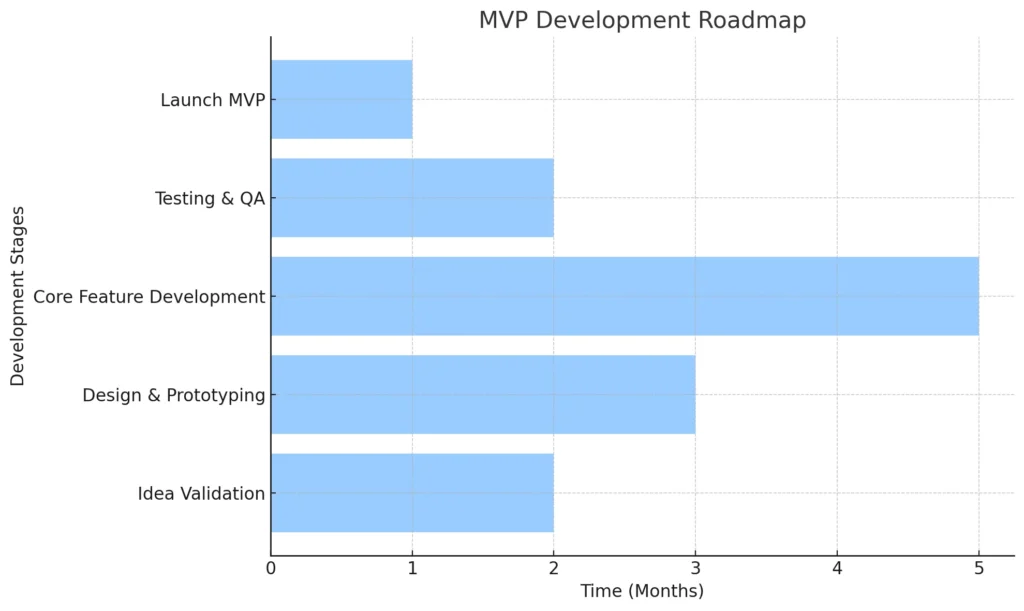
When developing a Foodpanda clone, it’s smart to start with a Minimum Viable Product (MVP). An MVP is the most basic version of your app that includes only the essential features needed to meet user demands and test the market. Launching with an MVP allows you to enter the market quickly, gather feedback, and continuously improve the app over time.
Why Build an MVP First?
- Cost-Effective: By focusing on the core features, you can reduce initial development costs and allocate resources for future updates based on real user feedback.
- Faster Time to Market: An MVP can be developed faster, helping you launch your app quickly and start building your customer base while refining the product.
- Real User Insights: By launching with a basic version, you can collect data from actual users, allowing you to better understand what features to prioritize in future iterations.
Core Features of an MVP for a Food Delivery App:
- User Registration: Simple sign-up and login options.
- Restaurant Listings: Basic functionality to browse restaurants by location.
- Order Placement: Ability for users to place and customize their orders.
- Real-Time Tracking: Basic GPS tracking for delivery status.
- Payment Integration: Essential payment methods like card payments and digital wallets.
- Admin Dashboard: A simple dashboard for restaurant management and order handling.
By starting with these key features, you can release a functional app that serves the basic needs of your users while minimizing risk. Once you’ve tested the waters, additional features like loyalty programs, reviews, and subscription models can be introduced gradually.
Read More “Instacart Business Model: How the App Works & Why It is Successful“
Technical Requirements
| Technical Area | Option 1 | Option 2 | Description |
|---|---|---|---|
| Frontend | React Native | Flutter | Both offer cross-platform development with fast performance and attractive UI. |
| Backend | Node.js | Python (Django/Flask) | Node.js is great for real-time events, while Python offers simplicity and speed. |
| APIs | Google Maps API | OpenStreetMap API | Google Maps provides robust location services, while OpenStreetMap is open-source. |
| Payment Gateway | Stripe | PayPal | Stripe offers flexible API integrations, while PayPal is widely recognized and trusted. |
| Database | MySQL | MongoDB | MySQL is relational and structured; MongoDB is NoSQL and suitable for large, unstructured data. |
Building a Foodpanda clone requires careful selection of the right technologies to ensure smooth performance, scalability, and security. The technical stack you choose will impact everything from user experience to how well the app handles high traffic.
Frontend Technologies:
For the user interface, the goal is to create a responsive and intuitive design that works seamlessly on both mobile and desktop platforms. Popular choices include:
- React Native: This framework allows for building cross-platform apps with a single codebase, reducing development time and cost. It’s known for providing a smooth user experience.
- Flutter: Backed by Google, Flutter also enables cross-platform development with high performance and attractive visuals.
Backend Technologies:
The backend is the engine of the app, handling data management, user authentication, and server-side processing. For a robust food delivery app, the following technologies are commonly used:
- Node.js: Known for its fast and scalable nature, Node.js is ideal for handling real-time events like order processing and live tracking.
- Python (Django/Flask): Python’s simplicity and flexibility make it a popular choice for backend development, offering rapid development and strong support for data-heavy apps.
APIs and Databases:
- Google Maps API: This is essential for enabling location-based services, like showing nearby restaurants and tracking deliveries in real-time.
- Payment Gateway Integrations: Secure payment gateways such as Stripe, PayPal, or local payment solutions should be integrated to handle transactions.
- Databases: Choose between MySQL or MongoDB, depending on whether your app needs a relational database (MySQL) or a flexible, document-based database (MongoDB) to handle large volumes of user and order data.
Launch your own delivery empire!
We’ll help you develop a seamless, feature-rich platform
inspired by Foodpanda.
Design and User Interface (UI/UX)
A successful Foodpanda clone hinges on its ability to offer users an intuitive and visually appealing experience. The design and user interface (UI) directly influence how users interact with the app, while the user experience (UX) ensures that these interactions are smooth, enjoyable, and frustration-free.
Importance of UI/UX:
In today’s competitive app market, delivering a sleek and efficient user experience can be a game-changer. If your app is easy to navigate and visually appealing, users are more likely to return. Poor design, on the other hand, can lead to high abandonment rates, with users deleting the app after a single use.
Best Practices for UI/UX:
- Simplified Navigation: Keep the interface uncluttered, ensuring users can quickly find restaurants, browse menus, and place orders without getting lost in complex menus.
- Personalization: Offer personalized recommendations based on users’ order history and preferences, making the app feel tailored to their tastes.
- Visual Hierarchy: Use clear fonts, contrasting colors, and bold icons to guide users through the app’s key features, like search, checkout, and order tracking.
- Interactive Elements: Include smooth animations, interactive buttons, and real-time feedback (e.g., “Order Confirmed!” pop-ups) to keep users engaged and informed at every step.
UI/UX Tools:
- Figma and Sketch are among the top tools used by designers to create wireframes and prototypes. These tools allow for collaboration between designers, developers, and stakeholders, ensuring the design is aligned with business goals and technical feasibility.
By focusing on intuitive design and a user-centric experience, your app can build a loyal customer base and stand out from the competition.
Development Process
Building a Foodpanda clone involves a structured and well-planned development process. Each step plays a vital role in ensuring that the app is functional, scalable, and ready for the market. Here’s a breakdown of the key stages in the development process, from idea to launch.
1. Idea Validation
Before diving into development, it’s essential to validate the idea. Conduct market research to understand customer needs, analyze competitors, and identify opportunities for differentiation. This step ensures that you’re building something with real demand and helps refine your concept before development starts.
2. Wireframing and Prototyping
This phase focuses on creating a visual blueprint of the app. Wireframes provide a basic layout of how the app will look and function, while prototypes give a more interactive experience. This allows the team to test user flows and make adjustments before moving into the coding phase.
3. Backend and Frontend Development
Once the design is finalized, development begins. The backend handles the server-side logic, databases, and APIs that power the app, while the frontend is where the user interacts with the app’s interface. The development team will work on:
- Frontend: Creating a smooth user interface with technologies like React Native or Flutter.
- Backend: Building the server-side infrastructure with tools like Node.js or Python to manage user data, order processing, and payments.
4. Testing and Quality Assurance (QA)
Testing is crucial to ensure the app is bug-free and performs well under different conditions. The QA team performs:
- Unit Testing: Testing individual components for functionality.
- User Acceptance Testing (UAT): Ensuring the app meets business requirements and user expectations.
- Load Testing: Making sure the app can handle high traffic without crashing or slowing down.
5. Deployment and Launch
Once testing is complete, the app is ready for deployment. It’s uploaded to app stores (Google Play Store, Apple App Store) and made available to users. This stage also includes monitoring the app post-launch to address any immediate issues and gather feedback for future updates.
By following this structured development process, your Foodpanda clone can be efficiently built and prepared for success in the market.
Cost Estimation and Timeframe
| Development Aspect | Cost Range (USD) | Timeframe |
|---|---|---|
| Basic Features (Core App) | $30,000 – $50,000 | 3 – 6 months |
| Advanced Features (e.g., GPS, Analytics) | $60,000 – $150,000 | 9 – 12 months |
| Freelancer (per hour) | $20 – $100 (depending on location) | Varies |
| In-house Team (Annual Salaries) | $80,000 – $150,000 per developer | Full-time |
| Outsourced Agency | $40,000 – $120,000 (project basis) | 3 – 9 months |
| Maintenance & Upgrades (Annual) | 15% – 20% of initial development cost | Ongoing |
Building a Foodpanda clone involves a range of costs that depend on several factors such as the complexity of features, the development team’s location, and the technologies used. Understanding the potential costs and timeframe will help you better plan your budget and schedule.
Development Costs Breakdown:
- App Features: The more complex your app, the higher the development cost. Features like real-time tracking, multiple payment gateways, and push notifications add to the complexity.
- Basic Features: User registration, restaurant listings, order placement, and payment integration.
- Advanced Features: Real-time GPS tracking, loyalty programs, personalized recommendations, and analytics dashboards.
- Development Team: Whether you hire an in-house team, freelancers, or outsource to an agency will impact costs.
- Freelancers: Typically cheaper but may require more management and time.
- In-house Team: More expensive due to salaries and benefits, but allows for close collaboration.
- Outsourced Agency: Agencies like Miracuves Solutions provide end-to-end services, handling everything from design to development and launch. They offer a balanced approach in terms of cost and expertise.
- Location of the Development Team: Costs also vary by region.
- US/UK developers: $100-$200 per hour.
- Eastern Europe developers: $40-$80 per hour.
- Asia-based developers: $20-$50 per hour.
Timeframe:
The total time to develop a Foodpanda clone depends on the project scope. For a basic app with core features, development can take approximately 3 to 6 months. However, if you’re including more advanced features, the timeline may extend to 9 to 12 months.
Example Breakdown:
- Basic App Development: $30,000 – $50,000
- Complex App Development: $60,000 – $150,000
- Maintenance and Upgrades: Ongoing costs (typically 15-20% of the development cost annually)
For an accurate estimate, it’s always best to work closely with development agencies like Miracuves Solutions, which provide transparent pricing based on your app’s specific requirements and scale.
Monetization Strategies
Once your Foodpanda clone is up and running, it’s crucial to have a solid plan in place to generate revenue. Food delivery apps offer several monetization avenues, allowing you to capitalize on the growing demand for convenience. Each strategy offers different ways to increase profitability while keeping users and partners engaged.
1. Commission Fees:
The most common monetization model for food delivery apps is charging restaurants a commission on every order. Typically, the platform takes a percentage of each transaction, which can range between 10% to 30% depending on the agreement. This method allows you to generate consistent revenue with every successful order.
2. Delivery Fees:
You can also charge customers a delivery fee, either as a flat rate or based on factors like distance or order size. To encourage more orders, many apps offer free or discounted delivery during non-peak hours or to premium subscribers. Delivery fees help offset the costs associated with logistics and delivery personnel.
3. Subscription Model:
Introducing a subscription service like “Foodpanda Plus” or “Uber Eats Pass” can be an excellent way to build loyalty while providing users with perks such as free delivery, exclusive deals, or early access to discounts. By charging users a monthly or annual fee, you create a steady income stream while enhancing the user experience.
4. In-App Advertising:
Advertising space can be sold to restaurants or third-party businesses. Restaurants can pay to have their listings appear at the top of search results or to feature special promotions. Additionally, you can offer banner ads or sponsored content, turning your app into a marketing platform.
5. Surge Pricing:
Another way to increase revenue is by implementing surge pricing during peak times, such as lunch or dinner hours, or during busy seasons. Users may be willing to pay a bit more for faster service, and restaurants can also share in the increased profits during these times.
6. Partnerships and Sponsored Listings:
Partnering with popular or exclusive restaurants for sponsored listings can generate additional revenue. These partnerships give restaurants increased visibility on the platform, while you benefit from premium fees.
Launching and Marketing the App
Successfully developing a Foodpanda clone is only half the battle—the next step is to ensure a powerful and strategic launch. This requires a well-planned marketing approach to capture the attention of your target audience, generate buzz, and drive app downloads.
1. App Store Optimization (ASO)
Just like SEO for websites, App Store Optimization (ASO) is crucial to increase the visibility of your app in the Apple App Store and Google Play Store. Optimize your app with:
- Relevant Keywords: Use keywords like “food delivery” or “order food online” in your app title, description, and tags to improve search rankings.
- Compelling App Description: Clearly explain the benefits of your app, its unique features, and why users should choose it over competitors.
- High-Quality Screenshots and Videos: Visuals give potential users a preview of the app experience. Make sure the images and videos highlight key features like fast delivery, easy navigation, and personalized recommendations.
2. Social Media Marketing
Leverage social media platforms like Instagram, Facebook, and TikTok to reach a wide audience. Create engaging content such as:
- Influencer Collaborations: Partner with local food bloggers or influencers to review your app and highlight its benefits.
- User-Generated Content: Encourage users to share their experience with your app by offering incentives or running contests.
- Targeted Ads: Use paid advertising to target specific demographics, locations, and interests, ensuring you reach the right audience at the right time.
3. Early User Acquisition and Promotions
To attract your first users, offer limited-time discounts or free deliveries for first-time customers. Create referral programs where existing users get rewards for inviting their friends, which will help in growing your user base quickly.
4. Partnerships with Restaurants
Build strong partnerships with popular local restaurants to create a buzz. These partnerships can include exclusive discounts or early access to new menu items, driving users to your app while also benefiting restaurants.
5. Email Marketing and Push Notifications
Stay connected with your users through regular updates, special offers, and promotions via email marketing. Additionally, use push notifications to engage users and remind them of deals, new restaurant listings, or their order status.
6. Collect Feedback and Improve
Once the app is live, continuously collect user feedback to improve the app. Early adopters often provide valuable insights on what’s working well and what needs improvement. Use this data to roll out new features and updates that enhance the user experience.
By combining these strategies, you can ensure a successful launch and position your Foodpanda clone for long-term growth and user loyalty.
Legal and Regulatory Considerations
When building a Foodpanda clone, navigating the legal and regulatory landscape is a crucial step that cannot be overlooked. Operating a food delivery app involves handling sensitive data, working with restaurants, and ensuring compliance with local laws. Adhering to these regulations not only safeguards your business but also builds trust with users and partners.
1. Data Privacy and Protection
One of the most critical legal aspects is ensuring that user data is handled securely. This includes protecting personal information such as names, addresses, and payment details. Depending on where your app operates, you will need to comply with data protection laws like:
- GDPR (General Data Protection Regulation): Applicable to businesses operating in or serving customers within the European Union, GDPR sets strict rules for collecting, processing, and storing user data.
- CCPA (California Consumer Privacy Act): Similar to GDPR, this law applies to businesses operating in California and focuses on consumer rights regarding personal data.
Ensure your app includes a clear privacy policy explaining how user data is collected, used, and protected. Implement industry-standard encryption methods for transactions and personal information to avoid breaches.
2. Food Safety and Health Regulations
When partnering with restaurants, it’s important to ensure they comply with local food safety laws. This includes food hygiene standards, safe packaging, and the correct handling of ingredients to prevent contamination. Some regions may require restaurants to display hygiene ratings, which could also be a feature you integrate into your app for transparency.
3. Delivery and Labor Laws
If you manage your own fleet of delivery drivers, you will need to comply with employment laws governing driver wages, working hours, and benefits. If your delivery system uses freelancers or independent contractors, it’s essential to define their status clearly to avoid legal complications regarding employment rights. Some regions also have specific rules governing gig workers, so it’s vital to stay informed.
4. Payment Compliance
Since your app will handle financial transactions, it is crucial to ensure compliance with local payment regulations. This includes implementing secure payment gateways, following anti-money laundering (AML) policies, and adhering to financial regulations in each country you operate in.
5. Terms and Conditions
Your app should have clearly defined terms and conditions to outline the rights and responsibilities of both users and restaurants. This document should cover various scenarios, such as order cancellations, refunds, and liability for late deliveries.
By addressing these legal and regulatory aspects, you can operate a Foodpanda clone smoothly and avoid costly legal issues down the road. Ensuring compliance also fosters trust among users and restaurant partners, helping you build a credible and sustainable business.
Read More ” How You Can Build App Like Swiggy“
Future Growth
Building a Foodpanda clone is just the beginning; ensuring its long-term success requires strategic planning for future growth. As the food delivery market continues to expand, your app needs to evolve with it. By focusing on scalability, user engagement, and continuous feature enhancement, your platform can stay competitive and profitable for years to come.
1. Scaling the App
As your user base and the number of restaurant partners grow, your app must be equipped to handle increased traffic without performance issues. This means investing in a scalable infrastructure that can support more users, restaurants, and delivery partners as your business expands.
- Cloud-based servers like AWS or Google Cloud offer flexible storage and computing power, allowing your app to handle higher demand during peak hours or in new regions.
- Ensure database optimization to handle large volumes of data efficiently, from user orders to real-time tracking information.
2. Expanding to New Markets
To maximize your app’s potential, consider expanding into new regions or even new verticals. For example, once your app is established in the food delivery space, you could branch out into:
- Grocery delivery
- Pharmacy deliveries
- Meal-kit subscriptions
Expanding into new territories also presents opportunities, but it comes with challenges such as adapting to local laws, setting up new delivery networks, and understanding regional customer preferences.
3. Adding New Features
Staying ahead in a competitive market requires continuous innovation. Regularly introduce new features to enhance the user experience and differentiate your app from competitors. Some potential future features include:
- Loyalty Programs: Implement a reward system where frequent users earn points or discounts for repeat orders.
- AI-based Recommendations: Use artificial intelligence to offer personalized restaurant and meal suggestions based on user preferences and past behavior.
- Voice Ordering: Allow users to place orders through voice commands, integrating with virtual assistants like Google Assistant or Alexa.
4. Partnerships and Collaborations
Forming strategic partnerships can help drive growth. Collaborate with local or national brands to offer exclusive deals or meal options. You could also partner with delivery services in other sectors, like package delivery, to diversify your platform’s offerings.
5. Staying Adaptable
The food delivery market is fast-moving, with constant changes in consumer behavior, technology, and competition. Be ready to adapt by closely monitoring market trends, user feedback, and competitors. This will help you identify opportunities for improvement and innovation.
By focusing on scalability, feature expansion, and strategic growth, your Foodpanda clone can remain competitive and continue to grow as the market evolves.
Why Trust Miracuves Solutions for Your Next Project?
| Feature | Miracuves Solutions | Other Agencies |
|---|---|---|
| Experience in Food Delivery Apps | Extensive experience with food delivery platforms like Foodpanda clones | May have limited experience in this specific niche |
| Tailored Solutions | Custom-built solutions to fit specific business needs | Often offer generic, template-based solutions |
| End-to-End Development Support | Full-cycle support from idea to launch and beyond | Often limited to initial development only |
| Scalability Focus | Built with future growth and scalability in mind | May not prioritize scalability in initial development |
| Transparent Pricing and Timelines | Clear cost breakdowns and deadlines provided upfront | Can have hidden costs or unclear timelines |
| Post-Launch Support | Ongoing maintenance and updates included | Limited or costly post-launch services |
When it comes to building a complex and feature-rich Foodpanda clone, the right development partner can make all the difference. Miracuves Solutions stands out as a trusted leader in the app development space, offering a comprehensive approach to ensure your project is a success. With a proven track record of delivering high-quality, scalable, and innovative apps, Miracuves Solutions provides the expertise and support necessary to turn your vision into reality.
1. Proven Expertise in App Development
Miracuves Solutions has years of experience developing custom apps across multiple industries, including food delivery. Our team of skilled developers, designers, and project managers brings a wealth of knowledge to every project, ensuring that your app is built with the latest technology and best practices.
2. Tailored Solutions for Your Business
Every business is unique, and Miracuves Solutions understands that. We work closely with you to understand your specific goals and requirements, crafting a personalized solution that meets your business needs. Whether you need basic app functionality or advanced features like real-time tracking, AI recommendations, or loyalty programs, our team can deliver a product that aligns with your vision.
3. Full-Cycle Development Support
From idea validation to post-launch support, Miracuves Solutions offers end-to-end development services. Our team is with you every step of the way, from designing wireframes and prototyping to testing, deployment, and ongoing maintenance. This ensures that your app is not only well-built but also supported long after launch.
4. Focus on Scalability and Future Growth
At Miracuves Solutions, we design apps with the future in mind. Our development process emphasizes scalability, ensuring your app can handle increasing user demand and expand into new markets seamlessly. We use modern cloud infrastructure and performance optimization techniques to ensure that your app can grow with your business.
5. Transparent Pricing and Timelines
With Miracuves Solutions, you can expect clear communication and transparency. We provide detailed cost breakdowns and development timelines so you always know what to expect, minimizing surprises and ensuring the project stays on track.
Partnering with Miracuves Solutions means your Foodpanda clone will be built by a dedicated team with the knowledge, tools, and passion needed to create a standout product in the competitive food delivery market.
Conclusion
Building a Foodpanda clone offers an exciting opportunity to tap into the rapidly growing food delivery market. With the right mix of essential features, a user-friendly interface, and a well-planned monetization strategy, you can create an app that competes with industry giants while carving out your own space in the market. From handling food orders and delivery logistics to managing restaurant partnerships, a successful app requires meticulous planning and a strong technical foundation.
The key to a successful launch is finding a reliable development partner who understands your vision and has the experience to bring it to life. Miracuves Solution offers the expertise, transparency, and full-cycle support necessary to guide your project from concept to launch, ensuring your app is built to scale and succeed.
By following the step-by-step development process outlined in this guide, and focusing on long-term growth and innovation, your Foodpanda clone can become a thriving part of the evolving food delivery landscape.
Want to build the next big food delivery app?
Let’s create a seamless FoodDelivery experience with smart logistics and secure payments.
FAQs
How long does it take to develop a Foodpanda clone?
The development timeline typically ranges from 3 to 9 months, depending on the complexity of features, design requirements, and testing stages.
What is the typical cost to build a food delivery app?
The cost can vary from $30,000 to $150,000 or more, depending on the app’s complexity, feature set, and the location of the development team.
Which tech stack is best for a food delivery app?
Popular tech stacks include React Native or Flutter for frontend development, and Node.js or Python for backend development, ensuring performance and scalability.
What are the key features required for an MVP?
An MVP should include core features like user registration, restaurant listings, order placement, real-time tracking, and payment integration to quickly launch and gather user feedback.
How do I monetize a food delivery app like Foodpanda?
Monetization options include commission fees, delivery charges, subscription services, and in-app advertising, each offering a reliable way to generate revenue.





